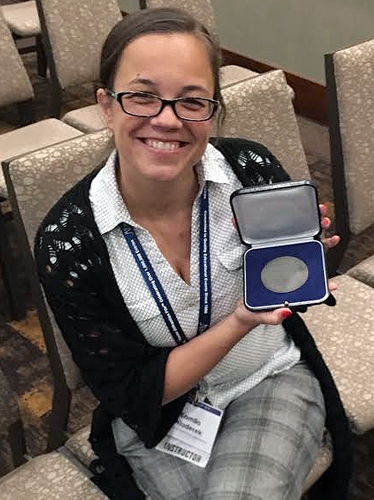 An international research team from the University of Cambridge, the U.S. Department of Energy’s Advanced Photon Source (APS) and Diamond Light Source, have been awarded the 2019 Charles Hatchett Award. Given for originality and technical excellence and the best paper on the science and technology of niobium-based materials, the winners were announced as Kent J. Griffith (UK), Kamila M. Wiaderek (USA), Giannantonio Cibin (UK), Lauren E. Marbella (UK) and Clare P. Grey (UK), for their paper published in Nature: “Niobium Tungsten Oxides for High-rate Lithium-ion Energy Storage,”
An international research team from the University of Cambridge, the U.S. Department of Energy’s Advanced Photon Source (APS) and Diamond Light Source, have been awarded the 2019 Charles Hatchett Award. Given for originality and technical excellence and the best paper on the science and technology of niobium-based materials, the winners were announced as Kent J. Griffith (UK), Kamila M. Wiaderek (USA), Giannantonio Cibin (UK), Lauren E. Marbella (UK) and Clare P. Grey (UK), for their paper published in Nature: “Niobium Tungsten Oxides for High-rate Lithium-ion Energy Storage,”
The University of Cambridge team have utilized resources of the Advanced Photon Source (APS), an Office of Science user facility at Argonne National Laboratory in the U.S. and at Diamond, the UK’s synchrotron, to study new materials that could improve the charging speed and storage capacity of rechargeable batteries for use in electric vehicles and mobile devices. Niobium tungsten oxide is able to store an unexpectedly large quantity of energy and the team used Argonne’s Multi-Purpose In-situ X-ray (AMPIX) cell for operando x-ray diffraction measurements at beamline 17-BM at the X-ray Science Divison (XSD) at the APS, aided by ex situ x-ray absorption spectroscopy measurements at beamline 9-BM (XSD, APS) and at the Core X-ray Absorption Spectroscopy beamline (B18) at Diamond, to investigate the chemical changes that occur in these materials.
Principal Beamline Scientist Giannantonio Cibin at Diamond explains; “We need to develop new electrode materials for batteries which will improve both charge/discharge rates and increase storage capacities. This is really important for growing markets such as electric vehicles, portable appliances and large-scale energy storage. This research highlights why two complex niobium-tungsten oxides show higher energy and power densities than those in battery materials currently available.”
The selection process of the Charles Hatchett Award is concerned with technical excellence and originality, but also takes account of the social, economic and environmental advantages of any proposed application of niobium. The International Panel for the Charles Hatchett Award commented, “This paper deals with a very important research topic with potential commercial applications involving the use of niobium: how to significantly increase the capacity and reduce the charging time of Li-ion batteries. The research used a very wide range of experimental methods, producing extensive experimental data. The potential applications of the technology could have clear sustainability-related impacts by promoting the use of non-carbon energy storage and usage.”
The team’s results showed that both niobium and tungsten ions are able to store "extra" charge in the battery, beyond what is usually expected, and that they work together. This is different from many battery materials containing multiple types of ion, where they are usually not active at the same time and some are not active at all. The new battery material is designed to be used as the negative electrode (anode), and to work with any of the many positive electrodes (cathodes) that are used in commercial lithium-ion batteries.
See: Kent J. Griffith1, Kamila M. Wiaderek2, Giannantonio Cibin3, Lauren E. Marbella1, and Clare P. Grey1*, “Niobium tungsten oxides for high-rate lithium-ion energy storage,” Nature 559, 556 (26 July 2018). DOI: 10.1038/s41586-018-0347-0
Author affiliations: 1University of Cambridge, 2Argonne National Laboratory, 3Diamond Light Source
Correspondence: *[email protected]
K.J.G. acknowledges support from The Winston Churchill Foundation of the United States, a Herchel Smith Scholarship, and a Science and Technology Facilities Council Futures Early Career Award. K.J.G. and C.P.G. thank the EPSRC for a LIBATT grant (EP/M009521/1). L.E.M. acknowledges support from the European Union’s Horizon 2020 research and innovation programme under the Marie Skłodowska–Curie grant agreement number 750294 and a Charles and Katharine Darwin Research Fellowship. We thank J. Skepper and H. Greer from the University of Cambridge for assistance with electron microscopy and M. Avdeev from the Bragg Institute for the bond valence sum mapping program. We thank O. Borkiewicz from the Advanced Photon Source at Argonne National Laboratory and A. Kasam from the University of Cambridge for diffraction data reduction scripts. We thank Diamond Light Source for access to beamline B18 (SP11433, SP14956, SP16387, SP17913). This research used resources of the Advanced Photon Source (GUP40466, GUP41657, GUP47967), a US Department of Energy (DOE) Office of Science User Facility operated for the DOE Office of Science by Argonne National Laboratory under contract number DE-AC02-06CH11357.
Argonne National Laboratory seeks solutions to pressing national problems in science and technology. The nation's first national laboratory, Argonne conducts leading-edge basic and applied scientific research in virtually every scientific discipline. Argonne researchers work closely with researchers from hundreds of companies, universities, and federal, state and municipal agencies to help them solve their specific problems, advance America's scientific leadership and prepare the nation for a better future. With employees from more than 60 nations, Argonne is managed by UChicago Argonne, LLC, for the U.S. DOE Office of Science.
The U.S. Department of Energy's Office of Science is the single largest supporter of basic research in the physical sciences in the United States and is working to address some of the most pressing challenges of our time. For more information, visit the Office of Science website.
